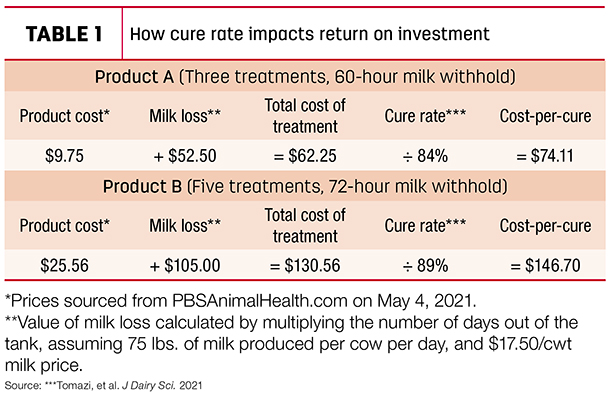Each case of mastitis in the first 30 days of lactation can be extremely costly to the dairy. Direct economic losses include diagnostics and treatment, veterinary fees, milk withhold and death loss. But longer-term, indirect mastitis costs can also add up – including future milk production and reproductive losses, as well as premature culling and replacement animal expenses.
As mastitis costs mount, it’s certainly worth investing in antibiotic treatment to preserve cow health and prevent these negative outcomes. But how can you be sure your treatment protocol delivers the best possible return on investment (ROI)?
When selecting mastitis treatments, it may be tempting to simply look at price per tube and choose the lowest-priced option. While product cost is important, it is just one factor in the overall cost of treatment.
Here are five considerations to help you optimize your economic returns from clinical mastitis treatment.
1. Target treatment for best chance of success
Milk culturing is one of the best ways to maximize ROI from mastitis therapy. Many different types of bacteria can cause clinical mastitis. By culturing milk samples, you can determine the specific pathogens of concern on your operation and with individual cases.
Some mastitis-causing bacteria are more responsive to antibiotic therapy than others. Based on culture results, you and your veterinarian can determine the best course of treatment – or whether antibiotic treatment is needed at all.
In the past few years, it has become well accepted that mild and moderate cases of clinical mastitis yielding no growth in the milk culture should not receive antimicrobials. In most no-growth cases, the cow immune system can eliminate the mastitis-causing pathogen without the aid of therapeutic intervention. No-growth cultures account for approximately a third of clinical mastitis cases occurring on dairy farms.
Gram-negative infections, such as E. coli, account for 25% to 30% of infections. These pathogens are much less responsive to treatment. Depending on the bacteria species, up to 94% of gram-negative mastitis cases self-cure without treatment.
Three separate studies show that gram-positive mastitis represents 35% to 42% of all clinical cases. Research demonstrates that antibiotic therapy has the highest success rate against gram-positive bacteria. Common gram-positive species that cause mastitis include Streptococcus agalactiae, Streptococcus spp., Staphylococcus aureus and coagulase-negative staphylococci.
It makes sense to focus your resources on the gram-positive cases most likely to respond to treatment. Milk culturing can facilitate targeted mastitis treatment, which also helps reduce antibiotic resistance by minimizing the use of broad-spectrum treatments.
2. Understand what it means to cure mastitis
Another key to cost-effective mastitis treatment is understanding the difference between a bacteriological cure and a clinical cure.
A bacteriological cure means bacteria are no longer present in the quarter. A clinical cure means milk no longer shows visual abnormalities and appears to be normal. This distinction is critically important because milk commonly continues to appear abnormal for several days after a bacteriological cure has been achieved. This is due to inflammation in the quarter, which begins to decrease after the bacteria are gone but takes time to fully clear.
It is not necessary to treat with antibiotics after a bacteriological cure has been achieved. Continuing treatment is a waste of money, both in terms of treatment cost and discarded milk, and may increase potential for development of antimicrobial resistance.
While treating beyond a bacteriological cure is unnecessary, it is still important to maximize the chances of achieving a bacteriological cure. When evaluating mastitis product options, ask your supplier or veterinarian for research data showing bacteriological cure results – not just clinical cure data.
3. Consider milk loss in treatment cost
Non-salable milk is one of the largest line item costs associated with mastitis treatment. To maintain revenue, strive to cure the case and get salable milk back into the tank as quickly as possible.
When selecting mastitis therapy, consider the duration of treatment and number of doses specified on the label, as well as the length of required milk withhold. Consider these factors to calculate your total cost of treatment:
Total cost of treatment = (Price per tube x number of treatments) + (Number of milkings withheld x production per milking x milk price)
4. Evaluate cost-of-cure
Another way to evaluate mastitis treatment costs is by calculating cost-of-cure. Even if total treatment costs are low, a treatment is not truly economical without a successful cure.
Dividing the total treatment costs by the cure rate reveals cost-per-cure – in other words, the true cost of mastitis treatment.
Compare these two example treatments to see how the cure rate impacts return on investment (Table 1).

5. Support responsible antibiotic use
An intangible cost of mastitis treatment is consumer trust. The use of antimicrobials to treat food animals is under increased scrutiny by consumers, government officials and regulatory agencies and must be well justified. Dairy producers can demonstrate responsible antibiotic use by only treating mastitis cases with the best chance of success. It’s also important to select microbial-targeted products and use the duration and dose required for a bacteriological cure.
Keep in mind, there is no single solution to mastitis that fits all dairies. Consult your veterinarian to determine the most cost-effective approach to mastitis treatment on your operation.
References omitted but are available upon request by sending an email to the editor.






